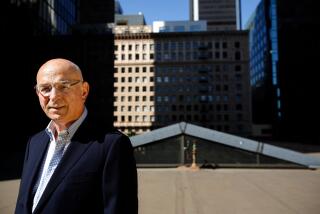From the Archives: Early American Black Architect, 85, Dead
Ask who designed Saks Fifth Avenue in Beverly Hills or Perino’s Restaurant in Los Angeles and few could come up with the name Paul R. Williams.
Fewer still would know he was black.
Yet when he died Wendesday at age 85 Williams left behind thousands of silent monuments to his artistic skills.
His commercial and public works projects include the Los Angeles Courthouse, Hall of Administration and three buildings at UCLA. Additionally, he was associate architect for Los Angeles International Airport.
And he designed homes — nearly 3,000 of them — for such stars as Tyrone Power, Bill (Bojangles) Robinson, Frank Sinatra, Cary Grant, Lon Chaney Sr., and dozens more.
Those homes embellish such communities as Hancock Park, Brentwood, Bel-Air and Flintridge.
He was the first black ever admitted to the American Institute of Architects and held five honorary degrees in addition to winning the National Association for the Advancement of Colored People’s Spingarn Medal for distinguished achievement.
Williams was born in Los Angeles on 8th Street (“way out in the country”) and attended Polytechnic High School and USC (where an adviser warned him “there aren’t enough Negroes in Los Angeles to give you a living.”)
He supported himself by cutting the letters “U” “S” “C” from brass and selling them as watch fobs and monograms.
In 1929, after he had established himself as a small-home specialist, auto magnate E. L. Cord hired Williams to design a Beverly Hills home on Cord’s 10-acre estate.
Williams designed a $400,000 mansion which featured an 18-car garage.
Impressed, Cord invited the young architect to meet a “friend” who turned out to be Adam Gimbel of the department store family. That meeting resulted in a commission to design Saks in Beverly Hills.
Later he was to extend his ventures to the Georgian-style Music Corp. of America Building and a 30-room Bel-Air Tudor mansion, both of which won national honors.
Although his large homes, treasured for their style, warmth and understated elegance, were mostly traditional, his smaller homes, such as the 25 he designed in Flintridge, tended toward the modern.
A gentle, courtly man, he also was a perfectionist who would have a plaster wall redone if he could feel a single trowel mark.
“He had the highest integrity,” said Mrs. Elaine Jones, widow of A. Quincy Jones, dean of the USC School of Architecture and Fine Arts. Williams and Jones were associated on many projects, including the Palm Springs Tennis Club.
At the pinnacle of his success, in the late 1930s, the nation of Colombia was seeking a designer for a hotel, office-building compex and homes in the city of Medellin.
The Colombian delegation, enchanted by Beverly Hills, chose five homes they particularly liked and inquired as to who had designed them. Three of them were Williams’ and he flew to that South American nation to oversee the project.
Winner of dozens of national and local awards, a scholarship fund has been set up in his name at 1930 Wilshire Blvd., Los Angeles 90057.
More to Read
Start your day right
Sign up for Essential California for the L.A. Times biggest news, features and recommendations in your inbox six days a week.
You may occasionally receive promotional content from the Los Angeles Times.






